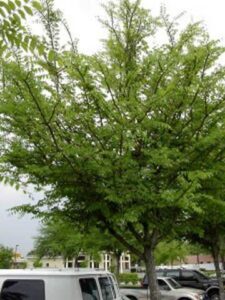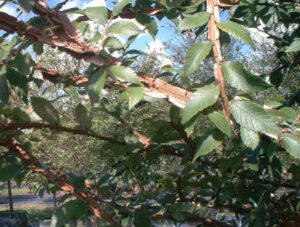S & J Nursery’s Guide to Growing
Winged Elm Tree
in the Northeast Florida Landscape
( Ulmus Alata ‘ Drake’ )
Winged Elm Origins: 
– native to the south eastern United States
Winged Elm Preferred Exposure:
– full sun
Winged Elm Foliage | Bark:
– deciduous foliage of the Winged Elm tree is a deep green color
turning yellow in the fall before falling off of the tree for the winter.
– The Winged Elm is named for its quite noticeable cork like outgrowths of bark on younger limbs giving the branches a somewhat winged appearance.
Winged Elm Soil Preference / Salt tolerance:
– widely adaptable to a range of soil compositions and moisture levels
Winged Elm Size Variance:
– can reach sizes ranging from 20-40 feet H | 15-30 feet W depending on pruning done
Winged Elm Growth Habit:
– upright slightly spreading but still taller than it is wide
Winged Elm Growth Rate:
– fast growth rate
Winged Elm Bloom:
– inconspicuous blooms followed by small round papery seed pods
Winged Elm Water Requirements:
– drought tolerant once established
 Best Uses For Winged Elms:
Best Uses For Winged Elms:
– Winged Elms can be used in the North Florida | Jacksonville | St. Augustine landscape where a moderately fast growing shade tree is needed. Winged Elms wide adaptability to a range of soil conditions makes it fit easily into most landscape situations including use as a street trees with a confined space for the roots to grow in.
Care of Winged Elms:
– water every day during the establishment period. See watering your newly planted trees for more information.
– prune as needed for shaping or raising the canopy above sight lines or
structural impediments
– provide a 1 ft diameter circle of mulched area where grass is kept from growing for each inch of caliper (or diameter) of trunk measured 4 inches from the ground level.
– fertilize each spring with a mixture of Milorganite and a slow release poly
coated plant food such as Osmocote or Stay Green general purpose plant food, sprinkling the fertilizer around the mulch circle underneath the foliage of the tree

